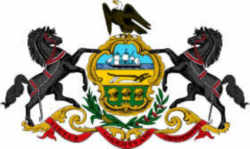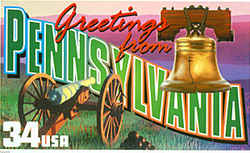Pennsylvania State Coat of Arms
Pennsylvania's Coat of Arms

Adopted in 1778.
The Pennsylvania's Coat of Arms was adopted in 1778. Pennsylvania's Coat of Arms, while not used in the same official capacity as the State Seal (although it contains the emblems of the seal), is perhaps a more familiar symbol of the Commonwealth of Pennsylvania. It appears on countless documents, letterheads, and publications, and forms the design on Pennsylvania's State Flag. Provincial Pennsylvania's coat of arms was that of the Penn family. A state coat of arms first appeared on state paper money issued in 1777. This first coat of arms was nearly identical to the State Seal, without the inscription. In 1778, Caleb Lownes of Philadelphia prepared a coat of arms. Heraldic in design, it consisted of: a shield, which displayed the emblems of the State Seal --- the ship, plough, and sheaves of wheat; an eagle for the crest; two black horses as supporters; and the motto "Virtue, Liberty and Independence." An olive branch and a cornstalk were crossed below the shield. Behind each horse was a stalk of corn, but these were omitted after 1805.
The Pennsylvania Coat of Arms
Numerous modifications were made to this coat of arms between 1778 and 1873, chiefly in the position and color of the supporting horses. In 1874, the legislature noted these variations and the lack of uniformity and appointed a commission to establish an official coat of arms for the Commonwealth. In 1875, the commission reported that it had adopted, almost unchanged, the coat of arms originally designed by Caleb Lownes ninety-six years earlier.
The coat of arms of Pennsylvania is an official emblem of the state, alongside the seal and state flag, and was adopted in 1778. The flag of the
Commonwealth of Pennsylvania consists of a blue field on which the state coat of arms is embroidered. The Pennsylvania coat of arms features a shield
crested by an American bald eagle, flanked by horses, and adorned with symbols of Pennsylvania's strengths- a ship carrying state commerce to all parts
of the world; a clay-red plough, a symbol of the Pennsylvania's rich natural resources; and three golden sheaves of wheat, representing fertile fields
and Pennsylvania's wealth of human thought and action. An olive branch and cornstalk cross limbs beneath- symbols of peace and prosperity. The state
motto, "Virtue Liberty and Independence", appears festooned below.
The coat of arms is surrounded by draft horses on both sides, and a bald eagle, which represents Pennsylvania's loyalty to the United States, above.
The state coat of arms includes a ship under full sail, a plow, and three sheaves of wheat indicating the significance of commerce, labor, perseverance,
and agriculture to the state. Surrounding the coat of arms are a stalk of Indian corn on the left and an olive branch on the right. These represent
the state's recognition of its past and its hope for the future. The scroll below the coat of arms reads, "Virtue, Liberty and Independence",
which is the state's motto








